How To Cover A Purple Bruise on Face (With Or Without Makeup)
Accidentally ending up with a vibrant purple bruise on the face is one of the fundamental challenges that you might encounter while applying makeup. Hiding the bruise is like a hidden rainbow with the help of sneaky science.
The right color-correcting code with proper camouflage can remove the bruise within no time. However, accepting this popular option, some natural tricks such as applying cold therapy, camouflaging with clothing, and some distraction tactics would help a lot to remove bruises from the face. However, the use of proper elements and application procedures is a must to start the process.
Besides, a purple bruise covering process might take 30 to 50 minutes based on the severity of the bruise, the skill level of the applicant, the desired level of coverage, and the products that are being used.
What Are Bruises And How Do They Form?
Before diving into the covering process, knowing about the bruise is important. It will help the applicant to understand the nature of bruises and to cover them based on the level of severity.
A bruise is a colorful patch that appears on our skin after an injury. In medical science, it is known as ecchymosis, which forms due to inflammation and starts the natural healing process of the body.
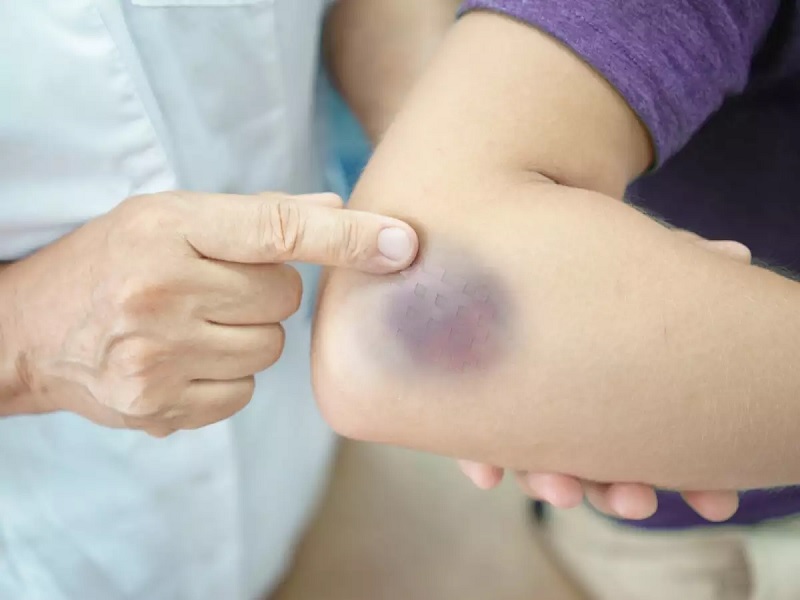
When the tiny blood vessels beneath the skin get damaged, the capillaries then leak the blood under the skin and form a bruise. The trapped blood beneath the skin further forms a purple bruise. But all bruises aren’t the same. The size of the bruise varies based on the severity level of the injury.
Remember, large-sized bruises are more difficult to cover as they change color over time due to the swelling and tender level of the skin. Besides, a small-sized bruise requires two weeks to heal, where the common symptoms reveal severe pain, swelling, and redness.
How to Cover a Purple Bruise with Makeup?
While covering a purple bruise, the applicant must have knowledge of color corrections and applying techniques with appropriate components. Otherwise, the wrong application can make things worse while expressing the bruise more.
Color Corrector
Imagine a color wheel that isn’t combined with proper shade over the paper. Similarly, when the wrong color combines in the face, the bruise won’t be hidden but rather show up more. Colors opposite each other on the wheel can help to hide the bruise effectively.
Thus, purple colors are the opposite of peach and yellow colors, which means peach and yellow tones used in the face can help to counteract the purple bruise. Here, you must consider the bruise color effect. In most cases, the bruises are of two types: reddish purple and bluish purple color. The peach or salmon color is best suited to the reddish-purple color bruise, and the yellow color best hides the bluish-purple bruise.
These color correctors contain some pigments, such as iron oxide, which counteract the purple tone of bruised skin. When the yellow color tone is applied, it neutralizes the unwanted color of the skin and makes the purple color invisible. But it can only hide the bruise; it won’t match with your skin color. To match the yellow tone with your skin color, you must consider the groundwork for the concealer to do its job effectively.
Which Color Corrector Should I Use?
Based on the skin tone and bruise color, the color corrector will vary. If you have a skin color in between light, fair, or deep, then the color corrector will vary as peach, light pink, and amber.
| Skin Tone | Skin Color Scheme | Bruise Nuance | Recommended Color Corrector |
Light | Reddish-purple | Peach or Salmon | |
| Bluish-purple | Yellow | ||
Fair | Reddish-purple | Light Pink | |
| Blueish-purple | Pale Yellow | ||
Deep | Reddish-purple | Rusty Orange | |
| Blueish-purple | Amber |
Fig: Skin Tone & Color Corrector Chart for Covering Purple Bruise
Human blood contains hemoglobin, which is a protein with several pigments. When the blood vessels rupture, the leaked blood beneath the skin contributes to initiating the formation of red and later purple shades over the skin. However, it depends on your skin color as well as how visible the bruise will be.
As the bruises appear purple due to the damaged blood vessels beneath the skin, combining the opposite color tone over it can help a lot to cover the area. But color correcting isn’t the only thing that requires it to be done properly.
Concealer
Concealer’s task is to give you the finishing touch in covering the bruise. It is crucial to apply the concealer in the right manner to make the coverage seamless. Thus, it will help unify your skin tone for a flawless look.
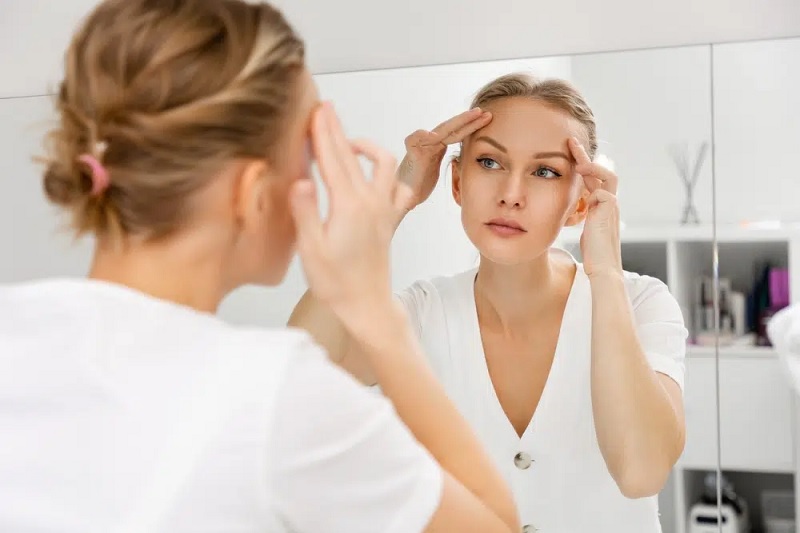
After the color correctors neutralize the specific color of your bruise, the concealer will come to perform the magic trick. It offers a broader coverage to diminish the mismatch between the color corrector and your skin tone. Also, concealers ensure that no residual darkness or unevenness is left over the bruise after color correction.
The concealer varies as well based on the skin tone. The right combination of concealer and color corrector will help you apply the makeup over the bruise without any hassle.
| Skin Tone Category | Skin Tone Description | Concealer Shade Recommendations |
Light | Very pale, almost translucent skin with pink or cool undertones | Ivory, Porcelain, Light Beige, Neutral Beige |
| Fair | Pale skin with pink, cool, or neutral undertones | Fair, Porcelain, Light Ivory |
Deep | Medium to dark skin with warm, cool, or neutral undertones | Caramel, Rich Coffee, Deep, Chestnut |
Fig: Concealer recommendation based on the skin tone category
How Concealer Helps to Cover the Bruise?
Concealers contain some ingredients such as titanium dioxide, iron oxide, and mica, which help the color corrector to blend with the skin tone by covering the bruise. The imperfection was covered by the color corrector and concealer and flourished a gentle natural skin tone, creating a unified appearance.
As a concealer, hydrating creams are best to use. It will help you to blend the bruise easily and avoid creasing, especially the sensitive parts of the skin, such as under the eyes or near a bruise. The cream will work best. Also, have medium-to-full coverage concealers which effectively conceal discoloration without looking unnatural.
Moreover, concealers are designed for these skin problems, too. If you require a thicker consistency, then consider applying extra camouflage for bruises.
Setting Powder
Applying the powder might seem like a minor detail, but it plays a crucial role in covering the bruise. For ensuring the longevity of your color corrector and concealer, the setting powder is very important. It will help the makeup stay put all day long.
The powder has the fine capacity to absorb excess oils and moisture from the skin. Thus, when the concealer and color correctors are trying to hide the bruise, the powder can help to hold it in place. The powder is a kind of interlock to the bruise, which helps to cover the sensitive areas like around the eyes and nose.
The powder has silica or dimethicone in its component, which helps the skin lock the makeup further and helps keep things smooth and crease-free.
Boosts longevity: By setting your makeup, you ensure it lasts longer, allowing you to confidently go about your day without worrying about touch-ups every hour. Besides, the water-resistance property of powder will help to stop melting the makeup down.
But when it comes to covering a purple bruise, translucent setting powder is the best powder product to choose. Translucent powders don’t have any additional color, and they neutralize and cover the purple tones. So, avoid colored powders and help your skin glow more.
Makeup Application to Cover the Purple Bruise (Step-by-Step Procedure)
The right makeup application technique is the next thing to consider when you are about to cover the bruise. With the help of a color corrector, concealer, and setting powder, the bruise can be covered, but only if the right process is being followed. These seven-step procedures would help to follow the right technique for applying the makeup over the bruise.
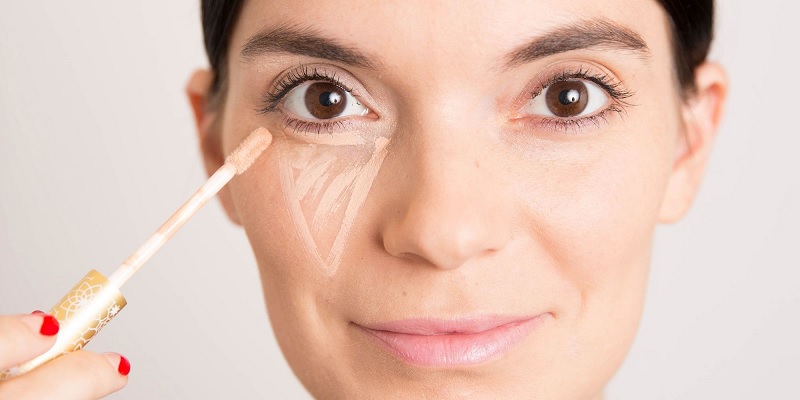
- For precautions, first wash your face with a gentle cleanser and wait till it gets dry. Don’t forget to ensure the skin is clean and free of any oil or moisturizer. It is a must; otherwise, the makeup won’t be settled properly over the skin.
- Next, gather tools such as a color corrector, concealer, and translucent setting powder to match your skin tone. Also, have a makeup sponge and fluffy powder brush to apply the concealer and color corrector.
- Start with dabbing a small amount of color corrector directly onto the bruised area while focusing on the most discolored parts. The best way to blend is by following the tapping motion to apply a gentle, damp sponge over it. Don’t make any sharp lines; rather, aim for a flawless transition to your natural skin tone.
- Now, start dotting with the concealer over the color-corrected area. Don’t try to swipe over it; otherwise, the color corrector may fade away. The sponge blends the concealer outwards so that you can ensure the color corrector and your skin tone.
- Apply a sufficient amount of concealer and blend the edges with your skin tone so the lines disappear over time.
- Now, it’s time to apply the translucent powder. Use a fluffy brush lightly into the setting powder and tap off any excess concealer or color corrector to avoid applying too much.
- Lastly, gente dust over the powder onto the concealed area will help to focus on areas prone to creasing, like under the eyes or near the nose.
Covering A Purple Bruise Without Makeup
If you don’t want to do the hassle of makeup, then some effective solutions would be using natural resources such as plants, cold compression, and vitamins. Though makeup offers a quick solution for covering a purple bruise, the natural alternatives can be time-consuming, and eventually, it will speed up the healing process.
The complete disappearance of bruises will take time, but some of these listed natural ingredients can help to minimize the appearance of your bruises.
Cold Compressor
Cold application is the fundamental and first-aid task while reducing the purple bruise. It is a natural healer that relaxes the ruptured blood vessels and reduces the blood flow over the area. Thus, the area becomes less reddish or purplish.
Also, the classic cold compress will never disappoint. First, take some ice cubes in a thin cloth and apply them to a bruised area for 15-20 minutes. Applying several times a day can work wonders. The cold temperature constricts blood vessels and helps to reduce swelling and pain.
It is suggested not to apply the ice directly over your skin because the direct ice can be irritating, and long-term application will be intolerable. Also, wrap the ice cubes in a thin cloth rather than wrapping them in thick towels.
Power of Plants
Some plants such as arnica, witch hazel, and calendula can help to reduce the color of the bruise by compressing it and reducing the swelling.
Arnica Gel
Arnica is one of the most vibrant flowering plants, which helps reduce the severity of the bruise. It has impressive anti-inflammatory properties that can reduce swelling and the intensity of your bruise’s purple coloration. The best application would be arnica gels or creams, which are readily available at most drugstores.
A thin layer directly to the bruised area 3 to 4 times a day can provide optimal results for most skin types. Arnica gel will fade away over time, which is why frequent application is required. But don’t use arnica gel if the skin is broken because the allergic component will react and irritate the area.
Witch Hazel Cream
Witch hazel has natural astringent and anti-inflammatory properties that will help to tighten the blood capillaries. Thus, it is called the helping hand for bruises. The mild anti-inflammatory and antiseptic properties offer relief to the area, and a calm, cold feeling will be formed. Also, hazel gel will potentially speed up the healing process.
However, the application process of witch hazel isn’t as simple as that of arnica gel. You must dilute the hazel with water in a ratio of 1:2 before applying it to the affected area. Also, use a cotton pad to dip and apply the solution over the bruised area. It also requires repetition of 2 to 3 times for better results.
Like any other cream or gel, witch hazel is forbidden to be applied over the eyes and open wounds.
Calendula Herb Oil
Calendula herb is known for its multi-tasking ability, offering pain-relieving and anti-inflammatory properties. Calendula oil is the best choice for applying over the bruised area. The bruised area will be massaged softly 2 to 3 times a day with this oil for a better result.
Before applying the herb oil, test it over normal skin and get an idea of allergic reactions. In some people, the herb oil causes allergic reactions, which are unpleasant. But, if the allergic reaction can be checked, herb oil can work faster than other hazel cream or arnica gel. Also, don’t forget to clean the skin before applying the oil.
Vitamin Supplementation
According to a study published in Engl J Med 2007 by Jan Stacpoole, Vitamin K deficiency delays bruise healing. Also, the National Institutes of Health Office of Dietary Supplements acknowledges that having vitamin K as a supplement while having a bruise can speed up the healing process.
Not only vitamin K but also vitamins C, D, and E can help to improve collagen production, fastening the healing process and reducing swelling and pain. But without the consultation of a doctor, having an unchecked amount of vitamins won’t be effective for the body. Also, the body’s requirement for vitamins is different and varies from person to person.
Safety Precaution While Covering The Bruise
While covering a bruise via makeup or natural concoction, safety measures should not be ignored. Many of us ignore the precautionary steps, which may further bring more severely damaged skin. Here are some key things to keep in mind while covering the bruise.
General Precautions
- Before applying the makeup or any natural ingredients, you must wash your hands thoroughly using detergent and running water before touching the bruised region or even when applying any products. This ensures the prevention of bacteria which may lead to infections.
- In case of a bruise associated with an open wound, applying anything except the hemostat will lead to misery. Visit a physician for the right treatment to avoid the risk of infection if you have an open wound related to the bruise.
- In case you are using any new products, such as creams, oils, or makeup, be sure to perform a small patch test on an inconspicuous skin area first. Wait for an hour after that to see whether any allergic reaction takes place, and then apply it on the bruise.
Makeup-Specific Precautions
- Use non-comedogenic products that are less likely to block pores and produce irritation. These non-comedogenic products are most suitable for sensitive skin.
- Don’t use harsh chemicals and fragrances to prevent irritation; opt for natural products that are made without any perfume.
- To make sure that the makeup does not look fake and also to prevent dirt or bacteria from getting trapped, apply cosmetics lightly but well-blended makeup.
- Brushes and sponges used for makeup application are colonized with bacteria; therefore, these implements should be cleaned regularly using suitable instruments and cleaning agents to deny their role in germ transfer.
Natural Remedy Precautions
- Make sure it will be safe for your skin type by testing on normal skin first for an hour of application.
- Certain natural remedies, such as witch hazel or essential oils, should be mixed with water or carrier oil in advance to develop them before use; otherwise, they may lead to irritations of the skin.
- If you are using a replacement remedy, consider it tentatively and monitor your skin reaction for some extensions to dispense with the chance of irritation before applying this more enhanced.
Frequently Asked Questions
Does Bruise Heal Naturally?
Yes, bruises will recover naturally. The human body slowly subsides the bruise by reducing the trapped blood level. However, patience is essential as the process of full recovery may take up to 2 weeks. In case of faster recovery, try some natural remedies such as cold compression and intake of vitamin-rich foods. Seek medical advice in case of intense or recurrent bruises.
What Color Covers Purple Bruise?
To cover the purple bruise, you must consider your skin tone. To cover a purple bruise over light skin, a peach or yellow color will be best to use. However, having a deep skin color will require a rusty orange or amber color. Lastly, people with fair skin tone should rely on light pink or pale yellow color. Also, don’t forget to blend with concealer after using the color corrector for better results.
Which Is Better To Cover Bruise: Concealer Or Corrector?
The choice between concealer and corrector for bruises depends on the severity of the bruise. For mild purple bruises, concealer alone (choose a shade slightly lighter than your skin) can suffice. For deeper discoloration, a color corrector (yellow to neutralize purple) followed by concealer is ideal. Also, don’t forget to do a patch test and prioritize gentle formulas to cover the bruise.
Conclusion
Although makeup and natural remedies can help reduce the purple bruise, the most suitable option differs from one person to another. Makeup is a quick solution to cover a bruise, but it requires skill and lots of attention.
Natural remedies, though very time-consuming, do have the potential to stimulate the healing process with less injury to the tissue. But always remember to patch-test any product before applying it to your skin. End of the day, patience is key, as bruises heal naturally over time. Focus on self-care and let your body work its magic!

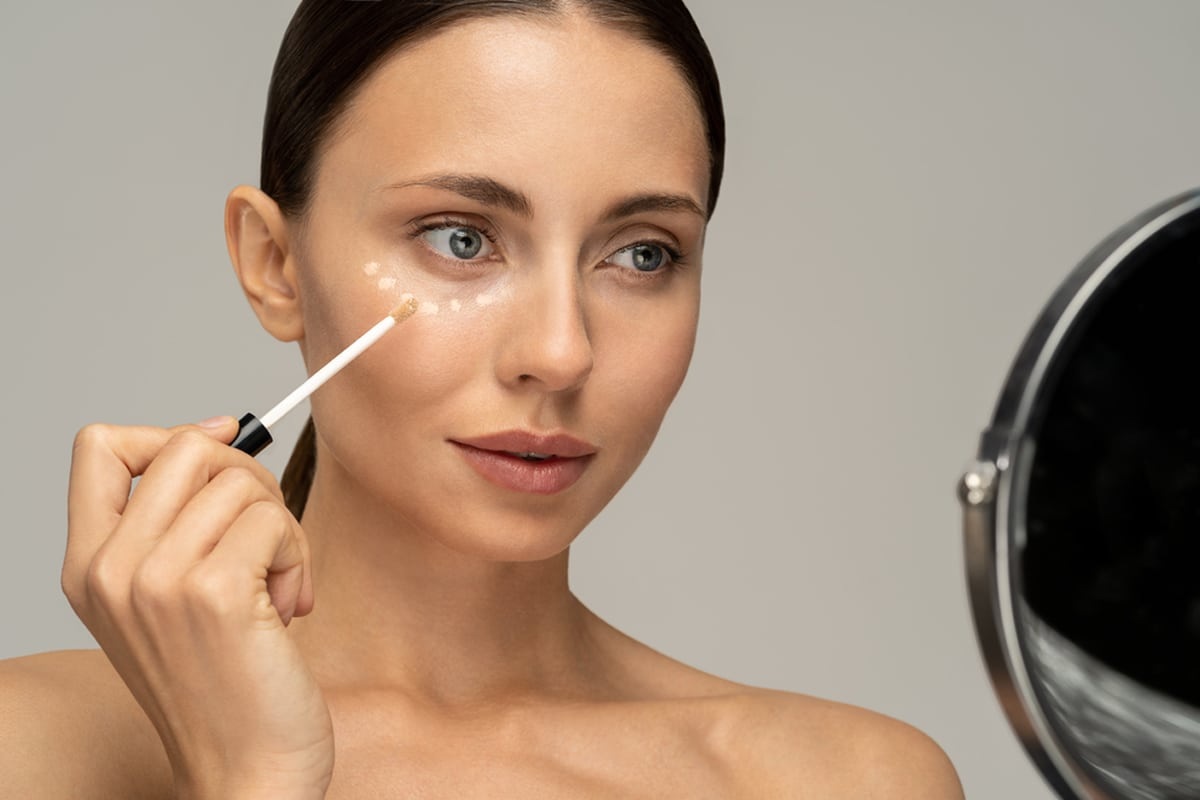
![Alternatives to Relaxers for Black Hair [Get Smooth Natural Hair]](https://landamedspa.com/wp-content/uploads/2025/05/Alternatives-to-Relaxers-for-Black-Hair-768x511.jpg)
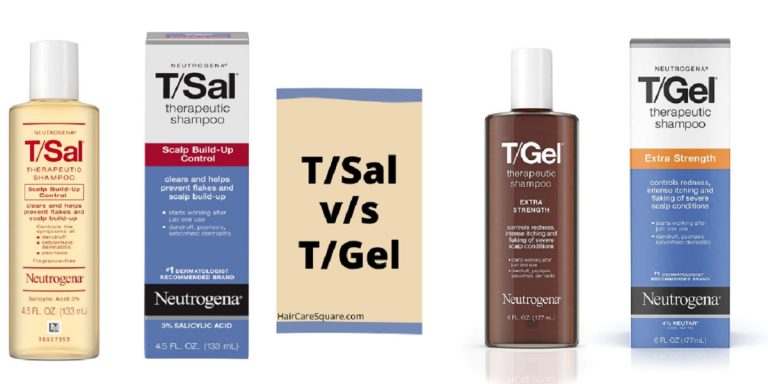
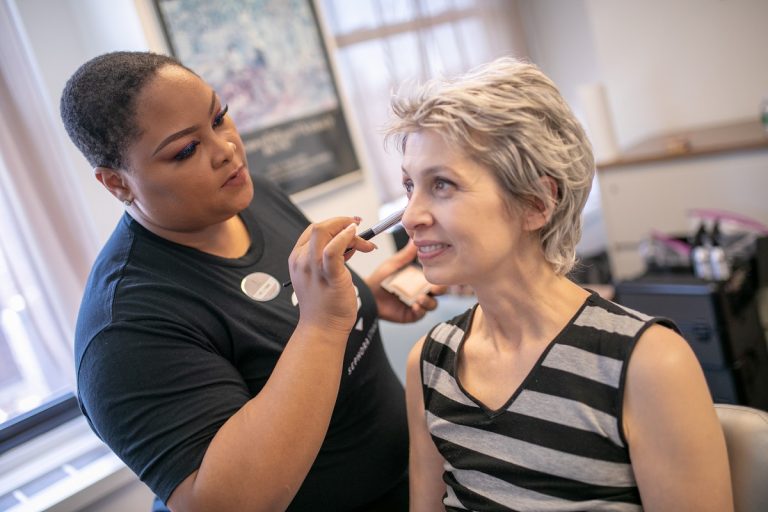
![Holiday Hair Prices, Opening Hours, Locations, Discount and Many More]](https://landamedspa.com/wp-content/uploads/2025/05/Holiday-Hair-Prices-Opening-Hours-Locations-Discount-and-Many-More-768x426.jpg)

